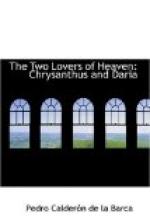In the admirable “Essay on the Genius of Calderon”
(ch. ii. p. 34), with which Archbishop Trench introduces
his spirited analysis of La Vida es Sueno, he refers
to the group of dramas which forms, with one exception,
the seventh and eighth divisions of the classification
above referred to, and pays a just tribute to the
superior merits of Los dos amantes del cielo.
After alluding to the dramas, the argument of which
is drawn from the Old Testament, and especially to
The Locks of Absalom, which he considers the noblest
specimen, he continues: “Still more have
to do with the heroic martyrdoms and other legends
of Christian antiquity, the victories of the Cross
of Christ over all the fleshly and spiritual wickednesses
of the ancient heathen world. To this theme,
which is one almost undrawn upon in our Elizabethan
drama,—Massinger’s Virgin Martyr
is the only example I remember,—he returns
continually, and he has elaborated these plays with
peculiar care. Of these The Wonder-working Magician
is most celebrated; but others, as The Joseph of Women,
The Two Lovers of Heaven, quite deserve to be placed
on a level, if not higher than it. A tender
pathetic grace is shed over this last, which gives
it a peculiar charm. Then too he has occupied
what one might venture to call the region of sacred
mythology, as in The Sibyl of the East, in which the
profound legends identifying the Cross of Calvary
and the Tree of Life are wrought up into a poem of
surpassing beauty".[2] An excellent German version
of Los dos amantes del cielo is to be found in the
second volume of the “Spanisches Theater”,
by Schack, whose important work on Dramatic Art and
Literature in Spain, is still untranslated into the
language of that country,—a singular neglect,
when his later and less elaborate work, “Poesie
and Kunst der Araber in Spanien und Sicilien”
(Berlin, 1865), has already found an excellent Spanish
interpreter in Don Juan Valera, two volumes of whose
“Poesia y Arte de los Arabes en Espana y Sicilia”
(Madrid, 1868), I was fortunate enough to meet with
during a recent visit to Spain.
The story of SS. Chrysanthus and Daria (The Two
Lovers of Heaven), whose martyrdom took place at Rome
A.D. 284, and whose festival occurs on the 25th of
October, is to be found in a very abridged form in
the “Legenda Aurea” of Jacobus de Voragine,
c. 152. The fullest account, and that which
Calderon had evidently before him when writing The
Two Lovers of Heaven, is given by Surius in his great
work, “De Probatis Sanctorum Vitis”, October,
p. 378. This history is referred to by Villegas
at the conclusion of his own condensed narrative in
the following passage, which I take from the old English
version of his Lives of Saints, by John Heigham, anno
1630.
“The Church doth celebrate the feast of SS.
Chrisanthus and Daria, the 25th of October, and their
death was in the year of our Lord God 284, in the
raigne of Numerianus, Emperor. The martyrdom
of these saints was written by Verinus and Armenius,
priests of St. Stephen, Pope and Martyr: Metaphrastes
enlarged it somewhat more. St. Damasus made
certain eloquent verses in praise of these saints,
and set them on their tombe. There is mention
of them also in the Romaine Martirologe, and in that
of Usuardus: as also in the 5. tome of Surius;
in Cardinal Baronius, and Gregory of Turonensis”,
p. 849.




